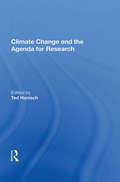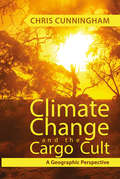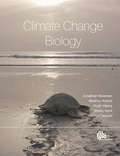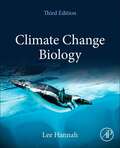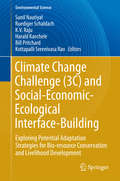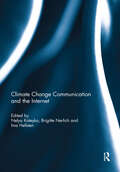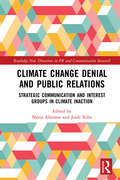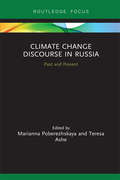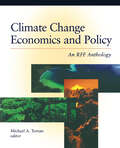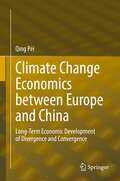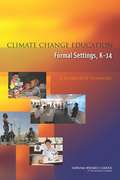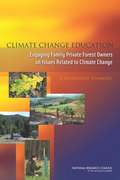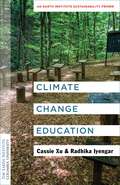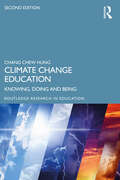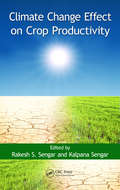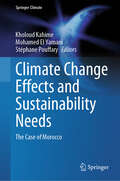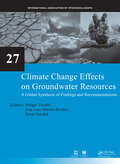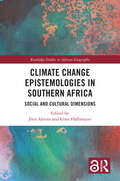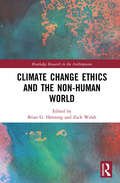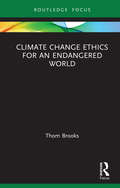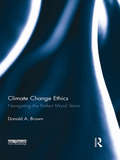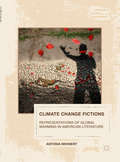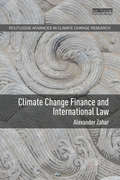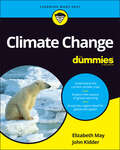- Table View
- List View
Climate Change And The Agenda For Research
by Ted HanischThis book presents essays that address the most strategic questions and challenges to scientists and policymakers on the important subject of climate change based on issues discussed at the 1992 Earth Summit. It considers how best to meet the challenge that atmospheric pollution poses worldwide.
Climate Change And The Cargo Cult: A Geographic Perspective
by Chris CunninghamClimate Change is a major threat to our way of life, and requires urgent political action to remedy its many threats, but is it a symptom rather than the disease? This book argues that the problem lies deep in our commitment to the quest for ever increasing economic growth. At some time in the 1970s the Western World passed a point of economic satiety beyond which further economic growth was of little benefit, and indeed was counter-productive, to living the good life. We must therefore seek a better understanding of our environment and of what constitutes genuine wealth. Life without the frenetic economic activity and culture of selfish possession that drives the modern economy can indeed be more humane, more pleasant and more meaningful than what we have today , but to reach it will require a major re-evaluation of what is important in business, politics and culture.
Climate Change Biology
by Madhur Anand Ze'Ev Gedalof Jonathan Newman Shelley Hunt Hugh HenryClimate change has moved from being a contested phenomenon to the top of the agenda at global summits. Climate Change Biology is the first major textbook to address the critical issue of how climate change may affect life on the planet, and particularly its impact on human populations. Presented in four parts, the first deals extensively with the physical evidence of climate change and various modelling efforts to predict its future. Biological responses are addressed in the second part, from the individual's physiology to populations and ecosystems, and further to considering adaptation and evolution. The third part examines the specific impact climate change may have on natural resources, agriculture and forestry. The final part considers research on the cutting edge of impact prediction and the practical and philosophical limitations on our abilities to predict these impacts. This text will be a useful asset to the growing number of both undergraduate and graduate courses on impacts of climate change, as well as providing a succinct overview for researchers new to the field.
Climate Change Biology
by Lee HannahClimate Change Biology, Third Edition, addresses how climate change may affect life on the planet, particularly its impact on biology. Presented in three parts, it deals extensively with the physical evidence of climate change and modeling efforts to predict its future. Biological responses are then addressed, from individual physiology, to populations and ecosystems, adaptation and evolution. The final section examines the specific impact climate change may have on natural resources, particularly relating to human livelihood. This book will be a useful asset to the growing number of both undergraduate and graduate courses on climate change. All sections are updated using the more than 5,000 research papers that have appeared on the topic since the publication of the second edition. Sections on the combined effects of ocean acidification and climate change are especially strengthened, with over six new case studies and end of chapter questions in each chapter.
Climate Change Challenge: Exploring Potential Adaptation Strategies for Bio-resource Conservation and Livelihood Development (Environmental Science and Engineering)
by Bill Pritchard Sunil Nautiyal Ruediger Schaldach K V Raju Harald Kaechele Kottapalli Sreenivasa RaoThis book is the outcome of two International Conferences held at the ISEC in Bangalore, India: the international conference on "Climate Change and Social-Ecological-Economical Interface-Building: Modelling Approach to Exploring Potential Adaptation Strategies for Bio-resource Conservation and Livelihood Development" held during 20-21 May 2015 and jointly organized by the Centre for Ecological Economics and Natural Resources (CEENR), Institute for Social and Economic Change (ISEC) and the Centre for Environmental Systems Research (CESR), University of Kassel, Germany; and the international conference "Climate Change and Food Security - the Global and Indian Contexts," jointly hosted by the CEENR, ISEC and the School of Geosciences, University of Sydney, on 18-19 February 2015. The selected papers presented in this book portray a broad range of international research efforts aimed at developing a deeper understanding of human-environment systems but also at translating scientific knowledge into political and societal solutions and responses to the challenge of climate change.
Climate Change Communication and the Internet
by Nelya Koteyko, Brigitte Nerlich and Iina HellstenThe volume provides a timely, state of the art collection of studies examining climate change communication in the era of digital media. The chapters focus on a broad range of topics covering various aspects of both practice and research in climate change communication, ranging from the use of online platforms, to blogs, and social networking sites. Climate change communication has increasingly moved into Internet-based forums, and this volume provides a comprehensive overview of research into Internet and climate change communication. The studies share valuable methodological insights in this relatively new field of research and shed light on the opportunities and challenges underlying the collection and analysis of online climate change-related data. This book was previously published as a special issue of Environmental Communication.
Climate Change Denial and Public Relations: Strategic communication and interest groups in climate inaction (Routledge New Directions in PR & Communication Research)
by Núria Almiron Jordi XifraThis is the first book on climate change denial and lobbying that combines the ideology of denial and the role of anthropocentrism in the study of interest groups and communication strategy. Climate Change Denial and Public Relations: Strategic Communication and Interest Groups in Climate Inaction is a critical approach to climate change denial from a strategic communication perspective. The book aims to provide an in-depth analysis of how strategic communication by interest groups is contributing to climate change inaction. It does this from a multidisciplinary perspective that expands the usual approach of climate change denialism and introduces a critical reflection on the roots of the problem, including the ethics of the denialist ideology and the rhetoric and role of climate change advocacy. Topics addressed include the power of persuasive narratives and discourses constructed to support climate inaction by lobbies and think tanks, the dominant human supremacist view and the patriarchal roots of denialists and advocates of climate change alike, the knowledge coalitions of the climate think tank networks, the denial strategies related to climate change of the nuclear, oil, and agrifood lobbies, the role of public relations firms, the anthropocentric roots of public relations, taboo topics such as human overpopulation and meat-eating, and the technological myth. This unique volume is recommended reading for students and scholars of communication and public relations.
Climate Change Discourse in Russia: Past and Present (Routledge Focus on Environment and Sustainability)
by Marianna Poberezhskaya Teresa AsheThis book explores the development of climate change discourses in Russia. It contributes to the study of climate change as a cultural idea by developing the extensive Anglophone literature on environmental science, politics and policy pertaining to climate change in the West to consider how Russian discourses of climate change have developed. Drawing on contributors specialising in numerous periods, regions, disciplines and topics of study, the central thread of this book is the shared attempt to understand how environmental issues, particularly climate change, have been understood, investigated and conceptualised in Soviet and post-Soviet Russia. The chapters aim to complement work on the history of the discursive political construction of climate change in the West by examining a highly contrasting (but intimately related) cultural context. Russia remains one of the world’s largest greenhouse gas emitters with one of the most carbon-intensive economies. As the world begins to suffer the extreme consequences of anthropogenic climate change, finding adequate solutions to global environmental problems necessitates the participation of all countries. Russia is a central actor in this global process and it, therefore, becomes increasingly important to understand climate change discourse in this region. Insights gained in this area may also be illuminating for examining environmental discourses in other resource rich regions of the world with alternative economic and political experiences to that of the West (e.g. China, Middle East). This book will be of great interest to students and scholars of Russian environmental policy and politics, climate change discourses, environmental communication and environment and sustainability in general.
Climate Change Economics and Policy: An RFF Anthology
by Michael A. TomanWhat are the potential adverse impacts of climate change? How can society determine the amount of protection against climate change that is warranted, given the benefits and costs of various policies? In concise, informative chapters, Climate Economics and Policy considers the key issues involved in one of the most important policy debates of our time. Beginning with an overview and policy history, it explores the potential impact of climate change on a variety of domains, including water resources, agriculture, and forests. The contributors then provide assessments of policies that will affect greenhouse gas emissions, including electricity restructuring, carbon sequestration in forests, and early reduction programs. In considering both domestic and international policy options, the authors examine command and control strategies, energy efficiency opportunities, taxes, emissions trading, subsidy reform, and inducements for technological progress. Both policymakers and the general public will find this volume to be a convenient and authoritative guide to climate change risk and policy. It is a useful resource for professional education programs, and an important addition for college courses in environmental economics and environmental studies. Climate Economics and Policy is a collection of Issue Briefs, prepared by the staff of Resources for the Future (RFF) and outside experts. Many are adapted from pieces originally disseminated on Weathervane, RFF‘s acclaimed web site on global climate change.
Climate Change Economics between Europe and China: Long-Term Economic Development of Divergence and Convergence
by Qing PeiThis book is the first attempt to highlight the Great Divergence between Europe and China from the perspective of environmental change. The author discusses the agrarian economy while considering the effects of climate change in both Europe and China at a long-term scale. The findings in the book supplement current knowledge and discussion on the Great Divergence across Eurasia. The book further aims to empirically review the climatic impacts on the human community in the past as the relevant historical reference by which to understand human–nature linkages in the current Anthropocene epoch. The statistical analysis in the book will contribute to the development of relevant subjects, such as environmental humanities, quantitative history, and historical geography. The book thus is suitable to all levels of students, undergraduate and postgraduate, in the university. In summary, by combining multiple disciplines in both methods and knowledge, this book becomes an interesting reference to students, academic staff, and even the general public. It may also appeal to policymakers, who aim to address the impacts of climate change according to past societal experiences.
Climate Change Education in Formal Settings, K-14: A Workshop Summary
by Alexandra BeattyClimate change is occurring, is very likely caused by human activities, and poses significant risks for a broad range of human and natural systems. Each additional ton of greenhouse gases emitted commits us to further change and greater risks. In the judgment of the Committee on America's Climate Choices, the environmental, economic, and humanitarian risks of climate change indicate a pressing need for substantial action to limit the magnitude of climate change and to prepare to adapt to its impacts. A principal message from the recent National Research Council report, America's Climate Choices, this brief summary of how climate change will shape many aspects of life in the foreseeable future emphasizes the vital importance of preparation for these changes. The report points to the importance of formal and informal education in supporting the public's understanding of those challenges climate change will bring, and in preparing current and future generations to act to limit the magnitude of climate change and respond to those challenges. Recognizing both the urgency and the difficulty of climate change education, the National Research Council, with support from the National Science Foundation, formed the Climate Change Education Roundtable. The roundtable brings together federal agency representatives with diverse experts and practitioners in the physical and natural sciences, social sciences, learning sciences, environmental education, education policy, extension education and outreach, resource management, and public policy to engage in discussion and explore educational strategies for addressing climate change. Two workshops were held to survey the landscape of climate change education. The first explored the goals for climate change education for various target audiences. The second workshop, which is the focus of this summary, was held on August 31 and September 1, 2011, and focused on the teaching and learning of climate change and climate science in formal education settings, from kindergarten through the first two years of college (K-14). This workshop, based on an already articulated need to teach climate change education, provided a forum for discussion of the evidence from research and practice. The goal of this workshop was to raise and explore complex questions around climate change education, and to address the current status of climate change education in grade K-14 of the formal education system by facilitating discussion between expert researchers and practitioners in complementary fields, such as education policy, teacher professional development, learning and cognitive science, K-12 and higher education administration, instructional design, curriculum development, and climate science. Climate Change Education in Formal Settings, K-14: A Workshop Summary summarizes the two workshops.
Climate Change Education: A Workshop Summary
by Alexandra S. BeattyThe forested land in the United States is an asset that is owned and managed by federal, state, and local governments, families, and other private groups including timber investment management organizations and real estate investment trusts. The over 10 million family forestland owners manage the largest percent (35 percent) of forestland acreage and the majority (62 percent) of the privately owned forestland. The Forest Service of the United States Department of Agriculture, which is responsible for the stewardship of all of the nation's forests, has long worked with private owners of forestland on forest management and preservation. All forestland is facing intensified threats because of the long-term effects of global climate change. The Forest Service recognizes that family forestland owners play a key role in protecting forestland and is working to identify optimal ways to engage this diverse group and support them in mitigating threats to the biologically diverse land they own. "Climate Change Education: Engaging Family Private Forest Owners on Issues Related to Climate Change" is the summary of a workshop convened by the National Research Council's Board on Science Education and Board on Environmental Change and Society as part of its Climate Change Education Roundtable series, to explore approaches to the challenge of preparing state foresters, extension agents, private forestry consultants, and other service providers who advise or otherwise intersect with private family forestland owners to take climate change into consideration when making decisions about their forests. The workshop focused on ways that findings from the behavioral, social, and educational sciences can be applied in engaging private individual, family, and community forestland owners in conversations about preparing for the impacts of climate change. This report discusses threats to forests posed by climate change and human actions; private forestland owners' objectives, values, knowledge, and dispositions about forest management, climate change, and related threats; and strategies for improving communication between forestland owners and service providers with respect to forest management in the face of climate change.
Climate Change Education: A Workshop Summary
by Martin StorksdieckClimate change poses challenges as well as opportunities for business and finance and, broadly speaking for the entire economy. Responding fully to the climate challenge will influence the economy of the United States and the world. Businesses will have to provide services or products with less harmful influence on the climate; respond to a changing policy, regulatory, and market environment; and provide new services and products to help address the challenges that will likely result from climate change. Many businesses are beginning to see climate change as another context within which core functions of strategy, finance, operations, marketing, or intersecting with regulatory environments occur, posing risks and opportunities. "Climate Change Education: Preparing Current and Future Business Leaders" is the summary of a workshop hosted by the National Research Council's Board on Science Education in March 2013 to explore issues associated with teaching climate change-related topics in business schools. The workshop focused on major gaps in our understanding of climate and sustainability education in postsecondary professional schools of business. The workshop connected discourse on climate education for current and future business leaders with the broader discussion on climate change education, in hopes that they influence and benefit each other. This report discusses the role that business schools could and should play in preparing future corporate leaders for the challenges and opportunities that climate change will pose.
Climate Change Education: An Earth Institute Sustainability Primer (Columbia University Earth Institute Sustainability Primers)
by Radhika Iyengar Luo Cassie XuClimate change affects every person and society, every community and industry. Education at all levels, in all disciplines, and both inside and outside official institutions must now address climate change and its many effects on social and environmental systems. This book provides a framework for putting climate change at the forefront of educational agendas and pedagogical tools for teaching climate science across local and global settings.Cassie Xu and Radhika Iyengar present evidence-based teaching practices and strategies that are grounded in a broad conception of education and emphasize a systems approach. They share examples of effective approaches in diverse learning environments—not just in classrooms and other formal settings but also informal contexts with communities and families. This book makes the case that students and other learners need to understand climate science and the physical and social impacts of climate change not only to be good citizens but also to be well prepared for different career paths. Xu and Iyengar highlight systemic barriers and inequalities, reflecting on how to bring marginalized voices and perspectives into educational spaces. Providing a foundation for interdisciplinary environmental education, this book underscores that how we teach future generations about climate change will shape our future.
Climate Change Education: Knowing, Doing and Being (Routledge Research in Education)
by Chang Chew HungClimate change is complex and there is a need to educate our future generations so that they are able to deal with the plethora of information and views that they come into contact with in their lives. This book inquires into what it means to teach and learn about climate change. Now in its second edition, Chang further explores what education for climate change entails, discussing the concept of climate change education (CCE) itself, how it is taught in schools and how public education is being carried out. Featuring updated literature in a quickly advancing field, the book defines CCE for the global citizen and looks at pedagogies supporting CCE. It also identifies teachers as key stakeholders in climate change discourse, how to improve teacher readiness on the topic and how teacher professional development can support successful implementation of CCE. This book will be invaluable to climate change educators and can act as a reference resource for teachers, education policymakers and public education agencies.
Climate Change Effect on Crop Productivity
by Rakesh S. Sengar Kalpana SengarExplore the Relationship between Crop and ClimateAgricultural sustainability has been gaining prominence in recent years and is now becoming the focal point of modern agriculture. Recognizing that crop production is very sensitive to climate change, Climate Change Effect on Crop Productivity explores this timely topic in-depth. Incorporating contri
Climate Change Effects and Sustainability Needs: The Case of Morocco (Springer Climate)
by Kholoud Kahime Mohamed El Yamani Stéphane PouffaryThis book provides simultaneously, a cross-sectoral, multi-scale assessment of climate change issues in Morocco and proposes levers of action and innovative practices to be used to strengthen the resilience and adaptation strategies. The book offers the opportunity to debate contemporary mutations, the paradigms of change as a complex process, the dynamics of values, the complexity of the issues and the opportunities for transformation, starting from a reflective approach on the historical, scientific, theoretical and strategic dimensions of action, creativity and environmental innovation in a perspective of sustainability.
Climate Change Effects on Groundwater Resources: A Global Synthesis of Findings and Recommendations (IAH - International Contributions to Hydrogeology)
by Holger Treidel & Jose Luis Martin-Bordes Jason J. GurdakClimate change is expected to modify the hydrological cycle and affect freshwater resources. Groundwater is a critical source of fresh drinking water for almost half of the worlds population and it also supplies irrigated agriculture. Groundwater is also important in sustaining streams, lakes, wetlands, and associated ecosystems. But despite this,
Climate Change Epistemologies in Southern Africa: Social and Cultural Dimensions (Routledge Studies in African Geography)
by Jörn Ahrens and Ernst HalbmayerThis book investigates the social and cultural dimensions of climate change in Southern Africa, focusing on how knowledge about climate change is conceived and conveyed. Despite contributing very little to the global production of emissions, the African continent looks set to be the hardest hit by climate change. Adopting a decolonial perspective, this book argues that knowledge and discourse about climate change has largely disregarded African epistemologies, leading to inequalities in knowledge systems. Only by considering regionally specific forms of conceptualizing, perceiving, and responding to climate change can these global problems be tackled. First exploring African epistemologies of climate change, the book then goes on to the social impacts of climate change, matters of climate justice, and finally institutional change and adaptation. Providing important insights into the social and cultural perception and communication of climate change in Africa, this book will be of interest to researchers from across the fields of African studies, sociology, anthropology, philosophy, political science, climate change, and geography.
Climate Change Ethics and the Non-Human World (Routledge Research in the Anthropocene)
by Zack Walsh Brian G. HenningThis book examines from different perspectives the moral significance of non-human members of the biotic community and their omission from climate ethics literature. The complexity of life in an age of rapid climate change demands the development of moral frameworks that recognize and respect the dignity and agency of both human and non-human organisms. Despite decades of careful work in non-anthropocentric approaches to environmental ethics, recent anthologies on climate ethics have largely omitted non-anthropocentric approaches. This multidisciplinary volume of international scholars tackles this lacuna by presenting novel work on non-anthropocentric approaches to climate ethics. Written in an accessible style, the text incorporates sentiocentric, biocentric, ecocentric, and posthuman perspectives on climate change. With diverse perspectives from both leading and emerging scholars of environmental ethics, geography, religious studies, conservation ecology, and environmental studies, this book will offer a valuable reading for students and scholars of these fields.
Climate Change Ethics for an Endangered World (Routledge Focus on Environment and Sustainability)
by Thom BrooksClimate change confronts us with our most pressing challenges today. The global consensus is clear that human activity is mostly to blame for its harmful effects, but there is disagreement about what should be done. While no shortage of proposals from ecological footprints and the polluter pays principle to adaptation technology and economic reforms, each offers a solution – but is climate change a problem we can solve? In this provocative new book, these popular proposals for ending or overcoming the threat of climate change are shown to offer no easy escape and each rest on an important mistake. Thom Brooks argues that a future environmental catastrophe is an event we can only delay or endure, but not avoid. This raises new ethical questions about how we should think about climate change. How should we reconceive sustainability without a status quo? Why is action more urgent and necessary than previously thought? What can we do to motivate and inspire hope? Many have misunderstood the kind of problem that climate change presents – as well as the daunting challenges we must face and overcome. Climate Change Ethics for an Endangered World is a critical guide on how we can better understand the fragile world around us before it is too late. This innovative book will be of great interest to students and scholars of climate change, climate justice, environmental policy and environmental ethics.
Climate Change Ethics: Navigating the Perfect Moral Storm
by Donald A. BrownClimate change is now the biggest challenge faced by humanity worldwide and ethics is the crucial missing component in the debate about what to do about this enormous threat. This book examines why thirty-five years of discussion of human-induced warming has failed to acknowledge fundamental ethical concerns, and subjects climate change’s most important policy questions to ethical analysis. This book examines why ethical principles have failed to gain traction in policy formation and recommends specific strategies to ensure that climate change policies are consistent with ethical principles. Because climate change is a global problem that requires a global solution and given that many nations refuse participation due to perceived inequities in proposed international solutions, this book explains why ensuring that nations, sub-national governments, organizations, businesses and individuals acknowledge and respond to their ethical obligations is both an ethical and practical mandate. This book is the first of its kind to go beyond a mere account of relevant ethical questions to offer a pragmatic guide on how to make ethical principles influential in formulating the world’s response to climate change. Written by Donald A. Brown, a leading voice in the field, it should be of interest to policy makers, and those studying environmental policy, climate change policy, international relations, environmental ethics and philosophy.
Climate Change Fictions: Representations of Global Warming in American Literature (Literatures, Cultures, and the Environment)
by Antonia MehnertThis book highlights the importance of the cultural sphere, and in particular literature, in response and discussion with the unprecedented phenomenon known as climate change. Antonia Mehnert turns to a set of contemporary American works of fiction, reading them as a unique response to the challenges of representing climate change. She draws on "climate change fiction"-- texts dealing explicitly with anthropogenic climate change--and explores how these works convey climate change, deal with its challenging characteristics, and with what narrative techniques they ultimately participate in its communication. Indeed, a number of challenging traits make climate change a difficult issue to engage with including its slow and long temporal dimension, global scale, scientific controversy, and its disconnect between cause and effect. Considering such complexity and uncertainty at the source of climate change fictions, this book moves beyond a solely ecocritical analysis and shows how these climate change fictions constitute an insightful cultural repertoire valuable for discussion in the environmental humanities in general.
Climate Change Finance and International Law (Routledge Advances in Climate Change Research)
by Alexander ZaharSince 2010, a significant quantity of international climate change finance has begun to reach developing countries. However, the transfer of finance under the international climate change regime – the legal and ethical obligations that underpin it, the constraints on its use, its intended outcomes, and its successes, failures, and future potential – constitutes a poorly understood topic. Climate Change Finance and International Law fills this gap in the legal scholarship. The book analyses the legal obligations of developed countries to financially support qualifying developing countries to pursue globally significant mitigation and adaptation outcomes, as well as the obligations of the latter under the international regime of financial support. Through case studies of climate finance mechanisms and a multitude of other sources, this book delivers a rich legal and empirical understanding of the implementation of states’ climate finance obligations to date. The book will be of interest to scholars and students of international law and policy, international relations, and the maturing field of climate change law.
Climate Change For Dummies
by Elizabeth May John KidderMaster the hottest—and most chilling—topic in the world today More and more frequent extreme weather events occur each year, and wildlife everywhere is increasingly endangered. Science fiction or science fact, most climate experts see this as our world on climate change—and, according to polls, a majority of people around the globe agree. Climate Change For Dummies allows you to investigate this hottest of hotly debated issues for yourself—examining its causes, the way it affects our lives, and what we can all do to make a difference. This straightforward guide—cowritten by the former leader of Canada's Green Party and the Canadian Chief of Staff to the Minister of Natural Resources—sifts the fact from the fiction: Is climate change caused by human activity or by natural elements beyond our control? What contribution can clean energy make? What are our best and worst-case scenarios? What are the likely long- and short-term effects? How can human activity can impact the environment? Can individuals and governments help reverse the possible effects? Which are the best sources of cleaner energy? With the IPCC predicting a 2.5–10°F warming over the next century, this complex subject will be making temperatures soar for years to come—on both sides of the debate. Climate Change For Dummies is the ideal tool to navigate these increasingly choppy waters—and to make an informed difference where you can.
